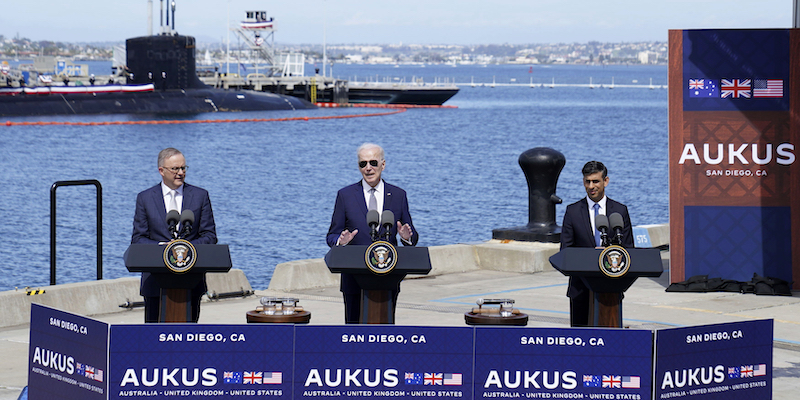US President Joe Biden and Prime Ministers Rishi Sunak and Anthony Albanese of the United Kingdom and Australia, respectively, announced in San Diego, California, the details of a three-phase project that will equip Australia with nuclear submarines, thanks to the sharing of military technology by the three countries. It is the central point of the agreement signed about a year and a half ago by the three countries (AUKUS, acronym of Australia, United Kingdom and United States), a military alliance with the implicit, but rather evident, objective of containing the expansion of China in the Pacific area.
The announcement of the birth of the alliance was made in September 2021 after a virtual meeting between the leaders of the three countries, but the details had not been released so far. The plan envisages a first phase in which the United States will deploy four nuclear submarines at the naval base in Perth, Australia (from 2027), a second in which it will sell between 3 and 5 submarines to Australia (from 2032) and a third in which Australia and the United Kingdom will complete the construction of a new fleet, thanks to the sharing of technologies of the three countries (from 2040).
Nuclear submarines are not a weapon like any other: they are based on very sophisticated technology, are strategically relevant and are currently owned by only six countries in the world (United States, Russia, France, United Kingdom, China and India). They use an engine powered by a nuclear reactor, which makes them much more powerful than conventionally fueled submarines: they are faster, can travel greater distances, spend more time underwater without having to surface to refuel, and are much more difficult to to be detected with radar and other types of instruments. They are potentially capable of launching missiles armed with miniaturized nuclear warheads, i.e. nuclear devices small enough to be assembled into missiles. However, President Biden specified that the Australian ones will be “nuclear-propelled, but not armed with nuclear warheads”.
– Read also: What is a nuclear submarine
The project has been strongly criticized by China and will equip the main US ally in the area (Australia) with a weapon capable of significantly increasing maritime control and potentially also operating in the South China Sea, an area considered highly at risk due to numerous territorial disputes between China and other countries, including Taiwan.
A moment before Monday’s announcement (AP Photo/Evan Vucci)
The three-phase agreement also includes the training of Australian pilots by the US Navy, the use of British technology developed by Rolls-Royce for the reactors, the supply by the United States of fuel for the reactors, the disposal of radioactive waste by Australia. Australia and the United Kingdom are expected to build up to eight submarines from the early 1940s and over the following two decades, bringing the British fleet to 19 units.
Biden called the AUKUS alliance “a tool to ensure stability in the Indo-Pacific area”, British Prime Minister Sunak cited North Korea, China and Iran, as well as Russia, as possible threats that could contribute to «designing a world characterized by danger, disorder and divisions». In addition to submarines, the alliance plans further collaboration to develop supersonic weapons and cybersecurity and artificial intelligence tools, which was not the subject of the announcement.
